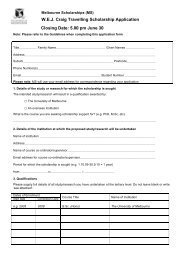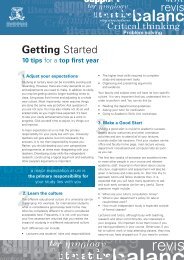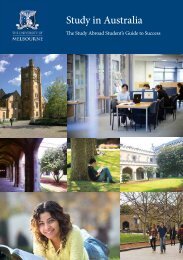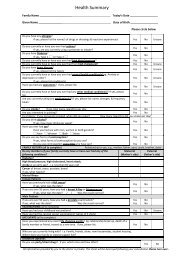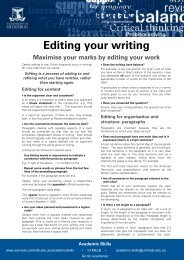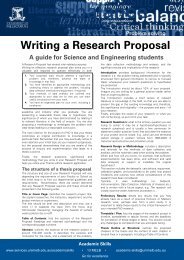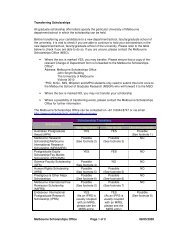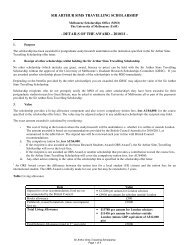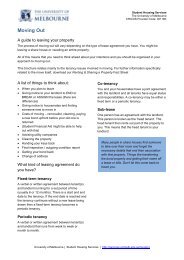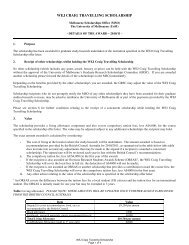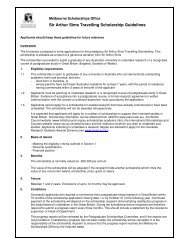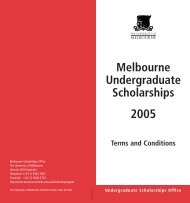a growing experience - Student Services - University of Melbourne
a growing experience - Student Services - University of Melbourne
a growing experience - Student Services - University of Melbourne
You also want an ePaper? Increase the reach of your titles
YUMPU automatically turns print PDFs into web optimized ePapers that Google loves.
HEALTH AND WELL-BEING OF INTERNATIONAL STUDENTSanalysis resulted in two functions based on four variables: course type (undergraduateor not), LOTE use (yes or no), Hong Kong student (yes or no), and student fromUK/USA/Canada (yes or no). However, using these two functions, only 50.9 per cent<strong>of</strong> students’ classifications could be made correctly. Because this is a clearlyunsatisfactory result, it was concluded that these common demographic variables didnot provide a useful basis for prediction <strong>of</strong> students’ mode <strong>of</strong> adaptation to universitylife in <strong>Melbourne</strong>. This suggests that the characteristic ways in which students adaptto university life might be more strongly associated with other factors, such aspersonal, behavioural and psychological factors, rather than with broad demographicfactors. If this is the case, then the three styles <strong>of</strong> adaptation resulting from thiscluster analysis could represent a typology applicable to domestic as well as tointernational students.If the typology is both valid and useful, one would expect that students’ satisfaction,psychological states and behaviour in different domains could be hypothesised todiffer, based on their style <strong>of</strong> adaptation. These would, <strong>of</strong> course, need to be differentdomains from the ones used to create the typology.One relevant area <strong>of</strong> interest concerns students’ use <strong>of</strong> university services, particularlythe health and counselling services. Do students with different styles <strong>of</strong> adaptationshow different patterns <strong>of</strong> service usage? Two aspects were investigated: students’perceptions <strong>of</strong> their need for help by these two services and their actual request forhelp, if they saw a need.• Fewer students than expected with a positive, connected style <strong>of</strong> adaptation sawthe need for health or counselling services. More students than expected with anunconnected and stressed or a distressed and risk-taking mode <strong>of</strong> adaptation feltthe need for help from the health or the counselling services 365 . These results areconsistent with the relative levels <strong>of</strong> physical and mental health, and <strong>of</strong> otherassociated variables, that define the three styles <strong>of</strong> adaptation.• Of those students who saw the need for help from the health or counsellingservice, more positive, connected adaptors than expected acted on their need,while fewer unconnected and stressed adaptors acted on their needs. <strong>Student</strong>swith a distressed and risk-taking mode <strong>of</strong> adaptation, acted on their needs at aboutthe expected level 366 . For students exhibiting the first two styles <strong>of</strong> adaptation(but not the third), this is consistent with the findings thato depression is a negative predictor <strong>of</strong> acting on the need for help from thehealth service and thato stress and cultural stress are negative predictors <strong>of</strong> seeking help from thecounselling service when there is a perceived need.<strong>Student</strong>s whose style <strong>of</strong> adaptation is positive and connected have the highest score onthe Connectedness scale and those whose style is unconnected and stressed have thelowest. It might therefore be expected that style <strong>of</strong> adaptation would distinguishamong students’ patterns <strong>of</strong> social mixing in Australia. This proved to be the case.<strong>Student</strong>s whose mode is unconnected and stressed mix significantly less withAustralians both within the <strong>University</strong> (D11) and <strong>of</strong>f campus (D17) than students witheither <strong>of</strong> the other two styles 367 . At the university, students whose style <strong>of</strong> adaptationis unconnected and stressed have the highest level <strong>of</strong> mixing with co-culturals (D3),365 Health: 2 = 24.83, 2 df, p



